3.5: Dividing Polynomials
( \newcommand{\kernel}{\mathrm{null}\,}\)
Learning Objectives
- Use long division to divide polynomials.
- Use synthetic division to divide polynomials.
Work in Progesss - do not read yet! (maybe take out all worked examples and hand out new ones in class) The exterior of the Lincoln Memorial in Washington, D.C., is a large rectangular solid with length 61.5 meters (m), width 40 m, and height 30 m.1 We can easily find the volume using elementary geometry.
V=l⋅w⋅h=61.5⋅40⋅30=73,800
So the volume is 73,800 cubic meters (m3).

Suppose we knew the volume, length, and width. We could divide to find the height.
h=Vl⋅w=73,80061.5⋅40=30
As we can confirm from the dimensions above, the height is 30 m. We can use similar methods to find any of the missing dimensions. We can also use the same method if any or all of the measurements contain variable expressions. For example, suppose the volume of a rectangular solid is given by the polynomial 3x4−3x3−33x2+54x. The length of the solid is given by 3x; the width is given by x−2.
To find the height of the solid, we can use polynomial division, which is the focus of this section.
Using Long Division to Divide Polynomials
We are familiar with the long division algorithm for ordinary arithmetic. We begin by dividing into the digits of the dividend that have the greatest place value. We divide, multiply, subtract, include the digit in the next place value position, and repeat. For example, let’s divide 178 by 3 using long division. Needs Work - replace!
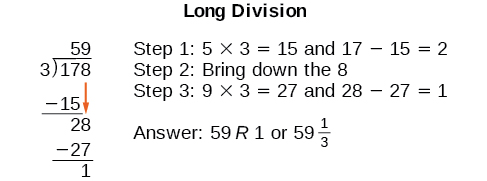
Another way to look at the solution is as a sum of parts. This should look familiar, since it is the same method used to check division in elementary arithmetic.
dividend=(divisor⋅quotient)+remainder178=(3⋅59)+1=177+1=178
We call this the Division Algorithm and will discuss it more formally after looking at an example.
Division of polynomials that contain more than one term has similarities to long division of whole numbers. We can write a polynomial dividend as the product of the divisor and the quotient added to the remainder. The terms of the polynomial division correspond to the digits (and place values) of the whole number division. This method allows us to divide two polynomials. For example, if we were to divide 2x3−3x2+4x+5 by x+2 using the long division algorithm, it would look like this: Needs work - replace!
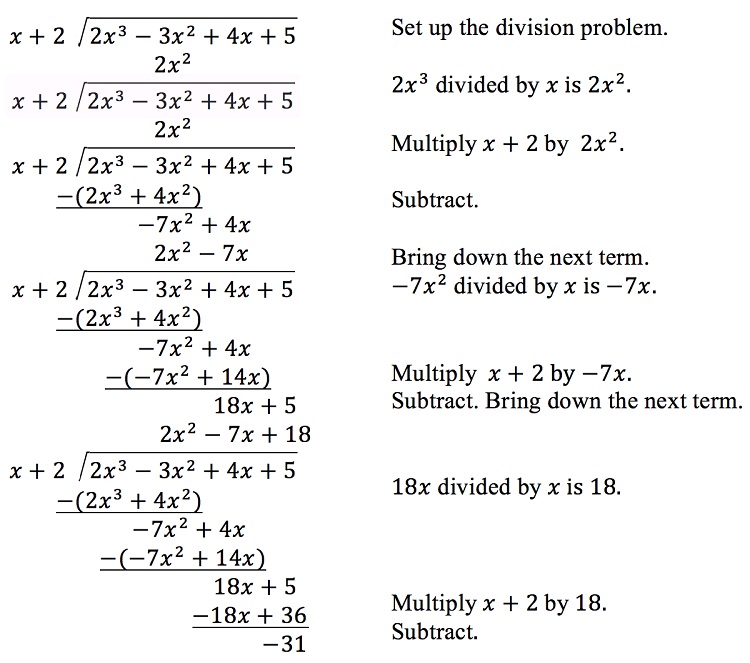
We have found
2x3−3x2+4x+5x+2=2x2−7x+18−31x+2
or
2x3−3x2+4x+5=(x+2)(2x2−7x+18)−31
We can identify the dividend, the divisor, the quotient, and the remainder.
Writing the result in this manner illustrates the Division Algorithm.
The Division Algorithm
The Division Algorithm states that, given a polynomial dividend f(x) and a non-zero polynomial divisor d(x) where the degree of d(x) is less than or equal to the degree of f(x), there exist unique polynomials q(x) and r(x) such that
f(x)=d(x)q(x)+r(x)
q(x) is the quotient and r(x) is the remainder. The remainder is either equal to zero or has degree strictly less than d(x).
If r(x)=0, then d(x) divides evenly into f(x). This means that, in this case, both d(x) and q(x) are factors of f(x).
![]() Given a polynomial and a binomial, use long division to divide the polynomial by the binomial
Given a polynomial and a binomial, use long division to divide the polynomial by the binomial
- Set up the division problem.
- Determine the first term of the quotient by dividing the leading term of the dividend by the leading term of the divisor.
- Multiply the answer by the divisor and write it below the like terms of the dividend.
- Subtract the bottom binomial from the top binomial.
- Bring down the next term of the dividend.
- Repeat steps 2–5 until reaching the last term of the dividend.
- If the remainder is non-zero, express as a fraction using the divisor as the denominator.
Example 3.5.1: Using Long Division to Divide a Second-Degree Polynomial
Divide 5x2+3x−2 by x+1. Needs Work - more space between steps! (replace!)
Solution
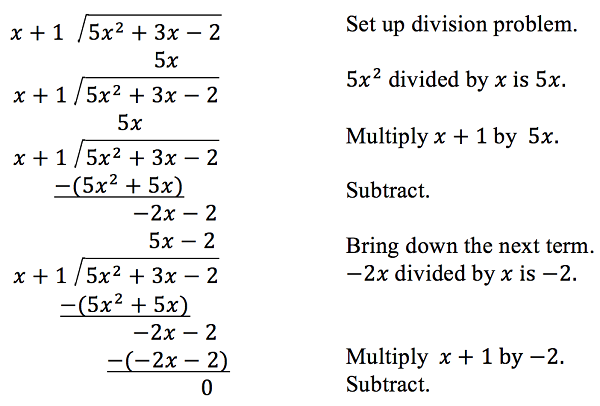
The quotient is 5x−2. The remainder is 0. We write the result as
5x2+3x−2x+1=5x−2
or
5x2+3x−2=(x+1)(5x−2)
Analysis
This division problem had a remainder of 0. This tells us that the dividend is divided evenly by the divisor, and that the divisor is a factor of the dividend.
Example 3.5.2: Using Long Division to Divide a Third-Degree Polynomial
Divide 6x3+11x2−31x+15 by 3x−2. Needs work - + sign in line 5 should be a minus! 21x in next line should be -21x! constant term of dividend should be 15! (screen shot)
Solution

There is a remainder of 1. We can express the result as:
6x3+11x2−31x+153x−2=2x2+5x−7+13x−2
Analysis
We can check our work by using the Division Algorithm to rewrite the solution. Then multiply.
(3x−2)(2x2+5x−7)+1=6x3+11x2−31x+15
Notice, as we write our result,
- the dividend is 6x3+11x2−31x+15
- the divisor is 3x−2
- the quotient is 2x2+5x−7
- the remainder is 1
![]() 3.5.2
3.5.2
Divide 16x3−12x2+20x−3 by 4x+5.
- Solution
-
4x2−8x+15−784x+5
Using Synthetic Division to Divide Polynomials
As we’ve seen, long division of polynomials can involve many steps and be quite cumbersome. Synthetic division is a shorthand method of dividing polynomials for the special case of dividing by a linear factor whose leading coefficient is 1.
To illustrate the process, recall the example at the beginning of the section.
Divide 2x3−3x2+4x+5 by x+2 using the long division algorithm.
The final form of the process looked like this: Make sure this matches example at beginning of section! (quotient is wrong here)
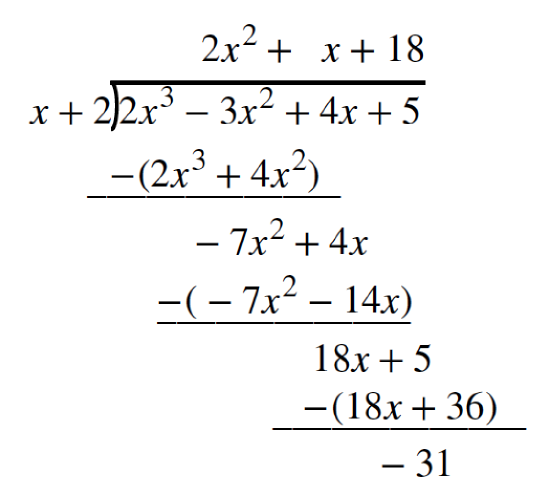
There is a lot of repetition in the table. If we don’t write the variables but, instead, line up their coefficients in columns under the division sign and also eliminate the partial products, we already have a simpler version of the entire problem.

Synthetic division carries this simplification even a few more steps. Collapse the table by moving each of the rows up to fill any vacant spots. Also, instead of dividing by 2, as we would in division of whole numbers, then multiplying and subtracting the middle product, we change the sign of the “divisor” to –2, multiply and add. The process starts by bringing down the leading coefficient.

We then multiply it by the “divisor” and add, repeating this process column by column, until there are no entries left. The bottom row represents the coefficients of the quotient; the last entry of the bottom row is the remainder. In this case, the quotient is 2x2–7x+18 and the remainder is –31.The process will be made more clear in Example 3.5.3.
Synthetic Division
Synthetic division is a shortcut that can be used when the divisor is a binomial in the form x−k. In synthetic division, only the coefficients are used in the division process.
![]() Given two polynomials, use synthetic division to divide
Given two polynomials, use synthetic division to divide
- Write k for the divisor.
- Write the coefficients of the dividend.
- Bring the lead coefficient down.
- Multiply the lead coefficient by k. Write the product in the next column.
- Add the terms of the second column.
- Multiply the result by k. Write the product in the next column.
- Repeat steps 5 and 6 for the remaining columns.
- Use the bottom numbers to write the quotient. The number in the last column is the remainder and has degree 0, the next number from the right has degree 1, the next number from the right has degree 2, and so on.
Example 3.5.3: Using Synthetic Division to Divide a Second-Degree Polynomial
Use synthetic division to divide 5x2−3x−36 by x−3.
Solution
Begin by setting up the synthetic division. Write k and the coefficients.

Bring down the lead coefficient. Multiply the lead coefficient by k.

Continue by adding the numbers in the second column. Multiply the resulting number by k.Write the result in the next column. Then add the numbers in the third column.

The result is 5x+12. The remainder is 0. So x−3 is a factor of the original polynomial.
Analysis
Just as with long division, we can check our work by multiplying the quotient by the divisor and adding the remainder.
(x−3)(5x+12)+0=5x2−3x−36
Example 3.5.4: Using Synthetic Division to Divide a Third-Degree Polynomial
Use synthetic division to divide 4x3+10x2−6x−20 by x+2.
Solution
The binomial divisor is x+2 so k=−2. Add each column, multiply the result by –2, and repeat until the last column is reached.

The result is 4x2+2x−10.
The remainder is 0. Thus, x+2 is a factor of 4x3+10x2−6x−20.
Analysis
The graph of the polynomial function f(x)=4x3+10x2−6x−20 in Figure 3.5.2 shows a zero at x=k=−2. This confirms that x+2 is a factor of 4x3+10x2−6x−20.
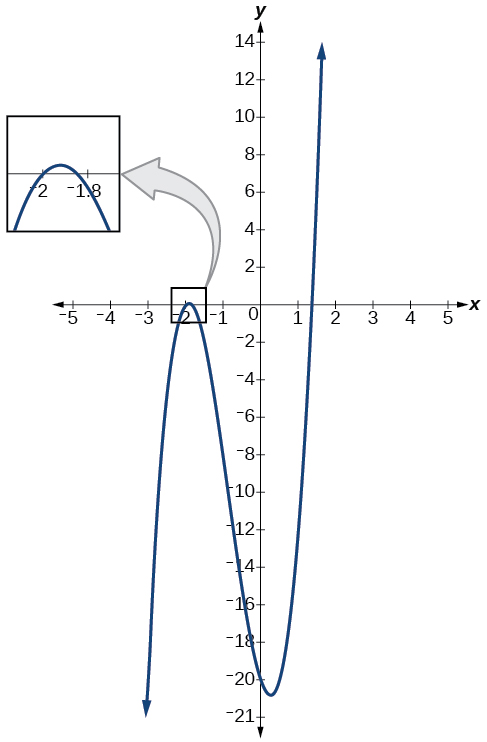
Example 3.5.5: Using Synthetic Division to Divide a Fourth-Degree Polynomial
Use synthetic division to divide −9x4+10x3+7x2−6 by x−1.
Solution
Notice there is no x-term. We will use a zero as the coefficient for that term.
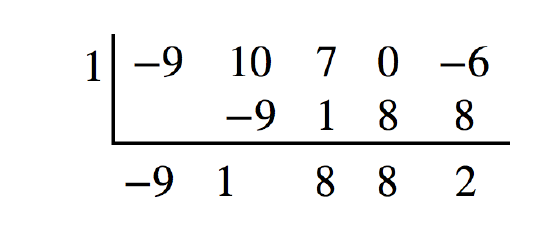
The result is −9x3+x2+8x+8+2x−1.
![]() 3.5.5
3.5.5
Use synthetic division to divide 3x4+18x3−3x+40 by x+7.
- Solution
-
3x3−3x2+21x−150+1,090x+7
Using Polynomial Division to Solve Application Problems
Polynomial division can be used to solve a variety of application problems involving expressions for area and volume. We looked at an application at the beginning of this section. Now we will solve that problem in the following example.
Example 3.5.6: Using Polynomial Division in an Application Problem
The volume of a rectangular solid is given by the polynomial 3x4−3x3−33x2+54x. The length of the solid is given by 3x and the width is given by x−2. Find the height of the solid.
Solution
There are a few ways to approach this problem. We need to divide the expression for the volume of the solid by the expressions for the length and width. Let us create a sketch as in Figure 3.5.3.

We can now write an equation by substituting the known values into the formula for the volume of a rectangular solid.
V=l⋅w⋅h3x4−3x3−33x2+54x=3x⋅(x−2)⋅h
To solve for h, first divide both sides by 3x.
3x⋅(x−2)⋅h3x=3x4−3x3−33x2+54x3x
(x−2)h=x3−x2−11x+18x−2
Now solve for h using synthetic division.
h=x3−x2−11x+18x−2

The quotient is x2+x−9 and the remainder is 0. The height of the solid is x2+x−9.
![]() 3.5.6
3.5.6
The area of a rectangle is given by 3x3+14x2−23x+6. The width of the rectangle is given by x+6. Find an expression for the length of the rectangle.
- Solution
-
3x2−4x+1
Key Equations
Division Algorithm f(x)=d(x)q(x)+r(x) where q(x)≠0
Key Concepts
- Polynomial long division can be used to divide a polynomial by any polynomial with equal or lower degree.
- The Division Algorithm tells us that a polynomial dividend can be written as the product of the divisor and the quotient added to the remainder.
- Synthetic division is a shortcut that can be used to divide a polynomial by a binomial in the form x−k.
- Polynomial division can be used to solve application problems, including area and volume.
Footnotes
1 National Park Service. "Lincoln Memorial Building Statistics." http://www.nps.gov/linc/historycultu...statistics.htm. Accessed 4/3/2014
Glossary
Division Algorithm
given a polynomial dividend f(x) and a non-zero polynomial divisor d(x) where the degree of d(x) is less than or equal to the degree of f(x), there exist unique polynomials q(x) and r(x) such that f(x)=d(x)q(x)+r(x) where q(x) is the quotient and r(x) is the remainder. The remainder is either equal to zero or has degree strictly less than d(x).
synthetic division
a shortcut method that can be used to divide a polynomial by a binomial of the form x−k
Contributors
Jay Abramson (Arizona State University) with contributing authors. Textbook content produced by OpenStax College is licensed under a Creative Commons Attribution License 4.0 license. Download for free at https://openstax.org/details/books/precalculus.


